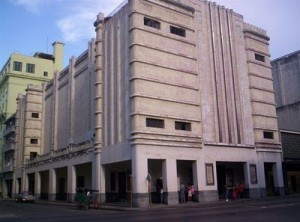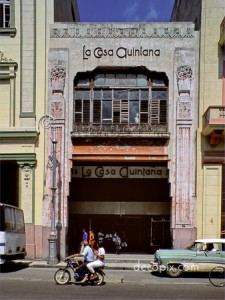World Congress attendees celebrating Art Deco in Havana complained about the state in which there are many buildings of its kind in the Cuban capital and the lack of control over the transformations undergone many properties by their inhabitants. It also warned of the need to recover resources Cuban heritage.
Congress welcomed Friday in the Casa de las Americas, a conference of the American researcher Michael Connors on the splendor of Art Deco in Havana.
Connors, author of The Splendor of Cuba and Cuban Elegance, showed photographs of a forthcoming book on Havana modernist, with collaboration of photographer Nestor Marti.
Connors closed cycle activities in the afternoon, after which participants responded to questions from the audience.
The main concerns expressed by participants focused on the lack of resources and collaboration need to restore Cuban Art Deco heritage.
A resident in an Art Deco building located on Calle 13 between 14 and 16, Vedado, asked to include the property in the remodeling plans emerging from the event. He said that the inhabitants of the building, concerned about their deterioration and loss of majesty, call its present “Art Mierdó”.
Another issue discussed was the passivity to action on Art Deco buildings, changing their appearance and are often performed by the same neighbors.
The architect Daniel Taboada explained that there are legal instruments to prevent it, but not to allocate financial resources to monitor violations inspectors.
He referred to unlicensed construction changing Art Deco structures. He warned that these changes are the response of homeowners to the need for restoration regardless urbanism.
The architect requested that the media take the message of the Congress to the people to begin to appreciate the urban architecture of Havana.
In parallel, remained in the exhibition hall of the Art Deco Best habanero including building models and drawings made by students of the Faculty of Architecture of the CUJAE (Instituto Superior Politecnico Jose Antonio Echeverria).
The XII World Congress on Art Deco began on Friday with the participation of more than 250 architects, historians, researchers and hobbyists to the artistic and decorative style, from Argentina, Brazil, USA, Canada, Colombia, China, Australia, New Zealand , South Africa and Spain among other countries. Close on March 21.
Sources: DDC/InternetPhotos/www.thecubanhistory.com
Cuba: State of buildings in Havana
The Cuban History, Arnoldo Varona, Editor
CUBA: ESTADO DE LOS EDIFICIOS HABANEROS
Asistentes al Congreso Mundial de Art Deco que celebra en La Habana se quejaron del estado en que se encuentran muchas construcciones de ese estilo en la capital cubana y del descontrol sobre las transformaciones que sufren muchos inmuebles por parte de sus habitantes. Asimismo, alertaron sobre la necesidad de recursos para recuperar el patrimonio cubano.
El Congreso acogió este viernes, en la Casa de las Américas, una conferencia del investigador norteamericano Michael Connors sobre el esplendor del Art Deco en La Habana.
Connors, autor de The Splendor of Cuba y Cuban Elegance, mostró fotografías de un libro en preparación sobre La Habana modernista, con colaboración del fotógrafo Néstor Martí.
Connors cerró el ciclo de actividades de la tarde, tras las cuales los participantes respondieron a preguntas del público.
Las principales inquietudes de los asistentes giraron en torno a la falta de recursos y necesidad de colaboración para la restauración del patrimonio Art Deco cubano.
Una residente en un edificio Art Deco ubicado en la calle 13 entre 14 y 16, en el Vedado, solicitó incluir el inmueble en los planes de remodelación que surgieran del evento. Indicó que los habitantes del edificio, preocupados por su deterioro y perdida de majestuosidad, llaman a su aspecto actual “Art Mierdó”.
Otro de los temas abordados fue la pasividad ante las acciones sobre edificios Art Deco, que cambian su apariencia y muchas veces son ejecutadas por los mismos vecinos.
El arquitecto Daniel Taboada explicó que existen instrumentos legales para evitarlo, pero no recursos económicos para destinar inspectores a controlar las violaciones.
Se refirió a construcciones sin licencia que cambian las estructuras Art Deco. Advirtió que esas transformaciones son la respuesta de los propietarios de las viviendas a la necesidad de restauración sin tener en cuenta el urbanismo.
El arquitecto pidió que los medios de prensa lleven el mensaje del Congreso a la población para comenzar a valorar la arquitectura urbanística de La Habana.
Paralelamente, se mantuvo en la sala la exposición Lo mejor del Art Deco habanero que incluye maquetas y dibujos de edificios elaborados por estudiantes de la Facultad de Arquitectura de la CUJAE (Instituto Superior Politécnico José Antonio Echevarría).
El XII Congreso Mundial de Art Deco se inició el viernes con la participación de más de 250 arquitectos, historiadores, investigadores y aficionados a ese estilo artístico y decorativo, procedentes Argentina, Brasil, Estados Unidos, Canadá, Colombia, China, Australia, Nueva Zelanda, Sudáfrica y España entre otros países. Cerrará el 21 de marzo.
Sources: DDC/InternetPhotos/www.thecubanhistory.com
Cuba: State of buildings in Havana
The Cuban History, Arnoldo Varona, Editor



 Art Deco: State of buildings in Havana. ** Art Deco: Situación de los edificios habaneros
Art Deco: State of buildings in Havana. ** Art Deco: Situación de los edificios habaneros

